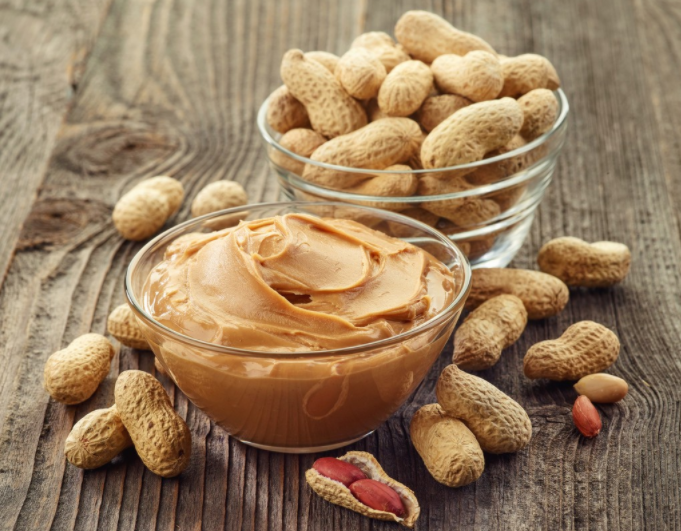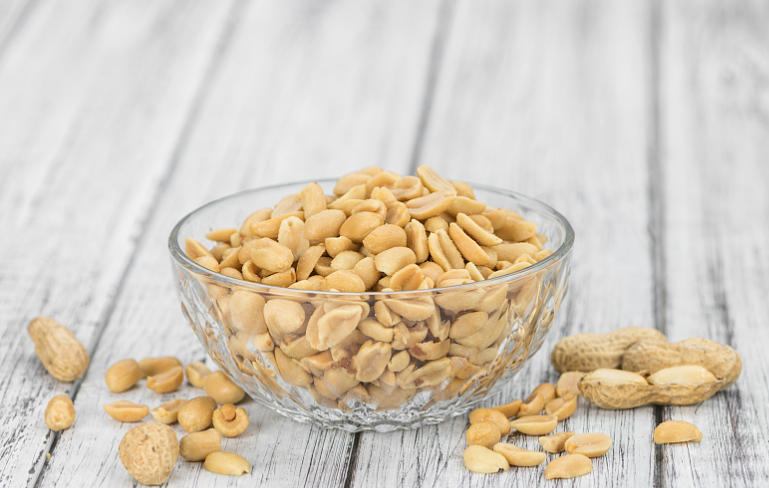1. Low-fat peanut kernels
Low-fat peanut kernels are peanut kernels extracted from 20% to 30% oil, and their appearance basically keeps the original shape. The process principle is: use strong pressure to squeeze the grease out of the cells, so as to achieve the purpose of degreasing. Two high-grade products can be obtained: high-grade peanut oil and low-fat peanut kernels. The operating pressure is 15-40 MPa, the processing capacity is 0-100 kg/time, and the processing time is 30-60 min each time. The biggest advantage of this method is that the defatted peanut kernel is also a product in itself, and it is a high-quality raw material for reprocessing other products. Because it is a normal temperature process, all nutrients and beneficial ingredients are not damaged.

2. New peanut butter
The current peanut butter is generally made from whole peanuts. Because the oil content of whole peanuts is too high, the oil content in peanut butter is reduced, and the production of new peanut butter is a development trend. The new peanut butter starts by changing the formula of the raw materials to increase the protein content accordingly. The appearance of the new peanut butter is not significantly different from the traditional peanut butter. The main difference between the production process and the current adding process is that a part of defatted peanuts is used in the raw material ratio. However, the nutrient content and nutritional value of the two peanut butters are obviously different. The ordinary peanut butter contains about 47% of fat, while the new peanut butter only contains 20% to 35% of fat. The protein content of the new peanut butter is increased by about 15%, and the carbohydrates are also The increase; the difference in moisture, ash, and fiber is not too big; the advantage is that the calorific value is correspondingly reduced.

3. Salty peanuts
Salty peanuts are also called salt and pepper peanuts. Salty peanuts are made by roasting and frying. No matter which method is used, high-quality peanut kernels must be used.
The basic process of making salted peanuts includes:
Peanut kernels→seeded peeling→color sorting→oil pressing (or baking)→cooling→coating→adding salt and antioxidants→sealing packaging→finished products.
The salty peanuts are light in color and unique in fragrance, with a salt content of 1.25%, no microorganisms, no rancidity, and a shelf life of up to 6 months. In recent years, in order to meet the market's demand for low-fat foods, the United States has developed a partially defatted salty peanut. Its preparation method is to first remove part of the fat from whole peanut kernels under mechanical pressure. This kind of low-fat salty peanut kernel has low oil content, so it has low calorific value, prolonged shelf life, soft taste and sweeter.

4. New peanut milk
The preparation method of peanut emulsion is: mix 1 part of peanut powder with 10 parts of water, and stir it vigorously until the emulsion is formed, heat the emulsion to 65~88 ℃, and continue to homogenize for 15~20 minutes, which can greatly improve the emulsion. The stability. Adding alkaline additives such as disodium phosphate or baking soda can prevent the precipitation of suspended small particles. Adding 1.0% to 1.2% of the total mass of disodium phosphate is sufficient to obtain satisfactory results, and adding 20% to 30% of refined peanut oil can increase the smoothness of the emulsion flow.
The characteristics of the new peanut milk are:
(1) High nutritional value, very easy to digest;
(2) Have various physical properties of dairy products and corn starch and other foods;
(3) Provides a basic raw material that can be used to further make various delicious foods and beverages;
(4) Form a stable, free-flowing milky liquid of peanut powder.
The above wonderful content is the sharing of Processing technology of peanut food by Henan Zhongxing Grain and Oil Machinery Co., Ltd. If you want to know more peanut processing technology, you can contact us at any time.
Copyright © Henan Zhongxing Grain And Oil Machinery Co.,Ltd. All Rights Reserved. Powered by MetInfo